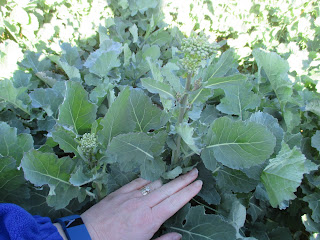 |
| Flowering canola plant. Princeton, KY. 21 Mar 2016. |
Carrie Knott, Extension
Agronomist-Princeton, University of Kentucky
Quite a bit of information for winter canola freeze injury
exists (see the end of the blog for links).
This past weekend, most of the state remained in the low-30s°F.
Weather data can be found at: wwwagwx.ca.uky.edu
or www.kymesonet.org. At these temperatures significant damage,
even to flowering canola is not expected.
The critical temperature for winter canola is mid- to low- 20s°F.
If these temperatures are maintained for at
least two hours, damage is expected. Wait at least 3 days and possibly a week
of warm temperatures before assessing damage.
As the amount of damage expected increases the length of time to assess
damage should also increase.
 |
| Canola plant at bolting growth stage. Princeton, KY. 21 Mar 2016. |
 |
| Canola plant at bud growth stage. The bud is enclosed by leaves. Princeton, KY. 21 Mar 2016. |
 |
| Canola at rosette growth stage. No buds can be found. Princeton, KY. 18 Mar 2016. |
According to information from Kansas State University:
“Canola
can recover from freezes in the mid-20s over a 3- to 7-hour time period with
little substantive damage at these stages. Temperatures below 20 degrees F can
be extremely damaging.
Cosmetic
injury will be observed immediately but canola should begin to recovery as soon
as temperatures warm up. The time it will take to allow a more realistic
estimate of the potential damage and recovery will depend on temperatures and
moisture conditions in the short term.
At the rosette stage, leaf burn will likely be observed. Watch as new
leaves start to emerge from the center of the rosette and see whether the crop
bolts normally. If the crop turns brown and does not show any new growth as
temperatures warm up, then the damage was likely severe and a yield reduction
can be expected.
At the bolting stage, some discoloration, or bleaching, will likely be
evident on leaf and stem tissue. The main stem and flower buds may turn white
or a shade of purple, which is just a symptom of cold temperatures and does not
necessarily indicate tissue damage. Stem splitting may be observed, but the
canola should continue to grow normally. Again, if stem and leaf tissues turn
brown and flowering does not follow, then damage was likely severe and a yield
reduction can be expected.
At the flowering stage, we often see bleaching of leaves and a bend or
crook in the stem and flowering racemes. Often, these bends may take the
flowering racemes to the ground; however, we have seen plants straighten and
continue flowering normally. The only problem may be that the racemes set seed
below the main canopy of pods, potentially creating problems at harvest. This
is the most common damage being reported in southern Kansas into Oklahoma
following the latest freeze.
Unopened buds [bud growth stage] should produce flowers and growing pods should produce viable
seed. The open flowers will be lost and permanent bends in racemes will be
observed. In severe cases, we have seen the main raceme and some secondary
branches completely freeze off and die. As the plant continues to flower, these
damaged plant parts will turn brown. The crop can compensate for the losses
with secondary branching.
Stem splitting and cracking are often observed following April freezes in
flowering canola. Canola will continue to grow even if the stem is split wide
open; however, these splits cause concern for lodging as the crop produces pods
and seeds. Cracks are usually cosmetic, but do provide an entry point for fungi
that could cause the stem to rot.
Splitting occurs when the stem fills up with ice and ruptures. This year,
some plants with translucent, mushy stems were observed the morning of the hard
freeze. It is too early to determine if this was severe enough to cause a
reduction in yield potential.
Longer
durations of temperatures in the mid-20s may increase the severity of damage.
The extent of damage and potential yield loss relative to how long it stays
this cold is somewhat of an unknown. But as long as the plants show normal
growth in the upcoming weeks, reasonable yields can be expected.”
For additional information visit:
No comments:
Post a Comment
Note: Only a member of this blog may post a comment.